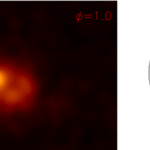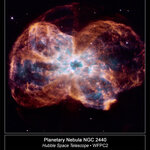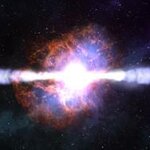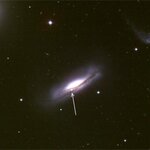Space

A powerful jet from a super massive black hole is blasting a nearby galaxy, according to new findings from NASA observatories. This never-before witnessed galactic violence may have a profound effect on planets in the jet's path and trigger a burst of star formation in its destructive wake.
Known as 3C321, the system contains two galaxies in orbit around each other. Data from NASA's Chandra X-ray Observatory show both galaxies contain super massive black holes at their centers, but the larger galaxy has a jet emanating from the vicinity of its black hole. The smaller galaxy apparently has…

Imagine two stars with winds so powerful that they eject an Earth's worth of material roughly once every month. Next, imagine those two winds colliding head-on. Such titanic collisions produce multimillion-degree gas, which radiates brilliantly in X-rays. Astronomers have conclusively identified the X-rays from about two-dozen of these systems in our Milky Way. But they have never seen one outside our galaxy — until now.
Thanks to the European Space Agency's XMM-Newton X-ray observatory, with help from NASA's Chandra X-ray Observatory, an international team led by Dr Yaël Nazé of the…

Liquid or gas flowed through cracks penetrating underground rock on ancient Mars, according to a report based on some of the first observations by NASA's Mars Reconnaissance Orbiter. These fluids may have produced conditions to support possible habitats for microbial life.
These ancient patterns were revealed when the most powerful telescopic camera ever sent to Mars began examining the planet last year. The camera showed features as small as approximately 3 feet (one meter) across. Mineralization took place deep underground, along faults and fractures. These mineral deposits became visible…

A strong wind blows sand and dust across the Mediterranean Sea from the Libyan Desert, located in the northeast section of the Sahara Desert, to Sicily and the southern tip of the Italian Peninsula on 10 February 2007 in this Envisat image.
Sandstorms are usually the result of atmospheric convection currents, which form when warm, lighter air rises and cold, heavier air sinks. The cold air in this image is visible stretching from the top left side of the image down to the centre and swirling back towards the north just above Libya (represented by the blue arrow in the image below), while the…

Ghostly galaxies composed almost entirely of dark matter speckle the universe. Unlike normal galaxies, these extreme systems contain very few stars and are almost devoid of gas. Most of the luminous matter, so common in most galaxies, has been stripped away, leaving behind a dark matter shadow. These intriguing galaxies-known as dwarf spheroidals-are so faint that, although researchers believe they exist throughout the universe, only those relatively close to Earth have ever been observed. And until recently, no scientific model proposed to unravel their origin could simultaneously explain…

This NASA Hubble Space Telescope image shows the colorful "last hurrah" of a star like our Sun. The star is ending its life by casting off its outer layers of gas, which formed a cocoon around the star's remaining core. Ultraviolet light from the dying star then makes the material glow. The burned-out star, called a white dwarf, appears as a white dot in the center. Our Milky Way Galaxy is littered with these stellar relics, called planetary nebulae. Hubble's Wide Field Planetary Camera 2 captured this image of planetary nebula NGC 2440 on Feb. 6, 2007.

Giant electrical circuits power the magical open-air light show of the auroras, forming arcs in high-latitude regions like Scandinavia. New results obtained thanks to ESA's Cluster satellites provide a new insight into the source of the difference between the two types of electrical circuits currently known to be associated to the auroral arcs.
The deep mechanisms that rule the creation of the beautiful auroras, or polar lights, have been the subject of studies that are keeping solar and plasma scientists busy since years. While early rockets and ground-observations have already provided a…

A new theory to explain the high-energy gamma-ray emissions from collapsing stars has been put forward by an international team of researchers. Their results will be published shortly in the Monthly Notices of the RAS.
Long duration gamma-ray bursts (GRBs), first discovered in the 1970s, are the most explosive events in the Universe. Finding out what happens during these cataclysmic events is a major challenge, partly because they usually occur at the edge of the visible Universe and partly because the bursts last only a matter of seconds.
When a massive star runs out of fuel, it no longer…

Supernovae stand out in the sky like cosmic lighthouses. Scientists at the Max Planck Institute for Astrophysics and at the National Astronomical Institute of Italy have now found a way to use these cosmic beacons to measure distances in space more accurately. The researchers have been able to show that all supernovae of a certain type explode with the same mass and the same energy - the brightness depends only on how much nickel the supernova contains. This knowledge has allowed the researchers to calibrate the brightness of supernovae with greater precision. This means that in the future,…

Astronomers from the University of Virginia and other institutions have found that Enceladus, the sixth-largest moon of Saturn, is a “cosmic graffiti artist,” pelting the surfaces of at least 11 other moons of Saturn with ice particles sprayed from its spewing surface geysers. This ice sandblasts the other moons, creating a reflective surface that makes them among the brightest bodies in the solar system (Enceladus, itself a ball of mostly ice, is the single most reflective body in our solar system).
“Enceladus’ art is a work-in-progress, constantly altering the surfaces of other moons…